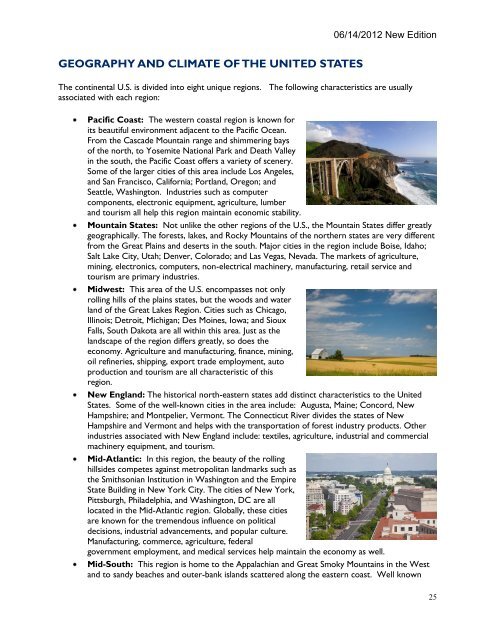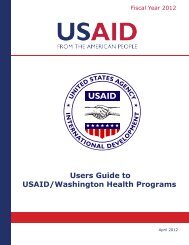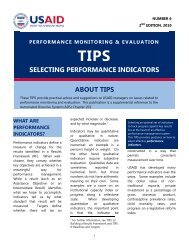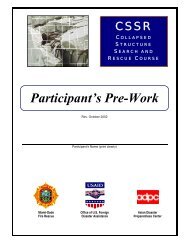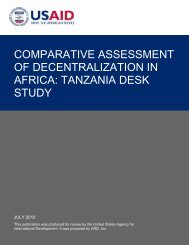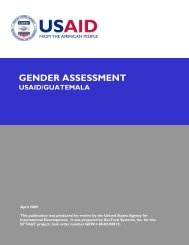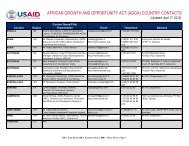Pre-Departure Orientation Manual - US Agency for International ...
Pre-Departure Orientation Manual - US Agency for International ...
Pre-Departure Orientation Manual - US Agency for International ...
Create successful ePaper yourself
Turn your PDF publications into a flip-book with our unique Google optimized e-Paper software.
GEOGRAPHY AND CLIMATE OF THE UNITED STATES<br />
06/14/2012 New Edition<br />
The continental U.S. is divided into eight unique regions. The following characteristics are usually<br />
associated with each region:<br />
Pacific Coast: The western coastal region is known <strong>for</strong><br />
its beautiful environment adjacent to the Pacific Ocean.<br />
From the Cascade Mountain range and shimmering bays<br />
of the north, to Yosemite National Park and Death Valley<br />
in the south, the Pacific Coast offers a variety of scenery.<br />
Some of the larger cities of this area include Los Angeles,<br />
and San Francisco, Cali<strong>for</strong>nia; Portland, Oregon; and<br />
Seattle, Washington. Industries such as computer<br />
components, electronic equipment, agriculture, lumber<br />
and tourism all help this region maintain economic stability.<br />
Mountain States: Not unlike the other regions of the U.S., the Mountain States differ greatly<br />
geographically. The <strong>for</strong>ests, lakes, and Rocky Mountains of the northern states are very different<br />
from the Great Plains and deserts in the south. Major cities in the region include Boise, Idaho;<br />
Salt Lake City, Utah; Denver, Colorado; and Las Vegas, Nevada. The markets of agriculture,<br />
mining, electronics, computers, non-electrical machinery, manufacturing, retail service and<br />
tourism are primary industries.<br />
Midwest: This area of the U.S. encompasses not only<br />
rolling hills of the plains states, but the woods and water<br />
land of the Great Lakes Region. Cities such as Chicago,<br />
Illinois; Detroit, Michigan; Des Moines, Iowa; and Sioux<br />
Falls, South Dakota are all within this area. Just as the<br />
landscape of the region differs greatly, so does the<br />
economy. Agriculture and manufacturing, finance, mining,<br />
oil refineries, shipping, export trade employment, auto<br />
production and tourism are all characteristic of this<br />
region.<br />
New England: The historical north-eastern states add distinct characteristics to the United<br />
States. Some of the well-known cities in the area include: Augusta, Maine; Concord, New<br />
Hampshire; and Montpelier, Vermont. The Connecticut River divides the states of New<br />
Hampshire and Vermont and helps with the transportation of <strong>for</strong>est industry products. Other<br />
industries associated with New England include: textiles, agriculture, industrial and commercial<br />
machinery equipment, and tourism.<br />
Mid-Atlantic: In this region, the beauty of the rolling<br />
hillsides competes against metropolitan landmarks such as<br />
the Smithsonian Institution in Washington and the Empire<br />
State Building in New York City. The cities of New York,<br />
Pittsburgh, Philadelphia, and Washington, DC are all<br />
located in the Mid-Atlantic region. Globally, these cities<br />
are known <strong>for</strong> the tremendous influence on political<br />
decisions, industrial advancements, and popular culture.<br />
Manufacturing, commerce, agriculture, federal<br />
government employment, and medical services help maintain the economy as well.<br />
Mid-South: This region is home to the Appalachian and Great Smoky Mountains in the West<br />
and to sandy beaches and outer-bank islands scattered along the eastern coast. Well known<br />
25


